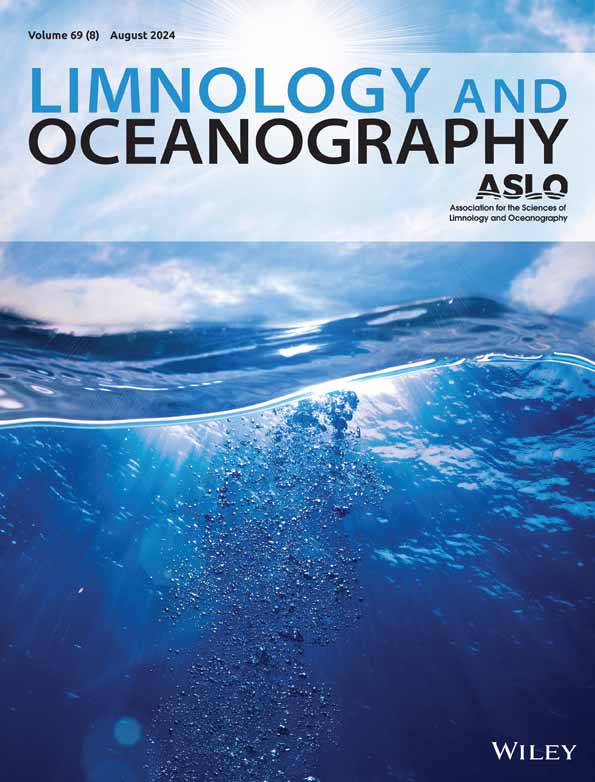Nutrient inversion but not warming drive changes in periphyton biomass and composition in shallow lake mesocosms
IF 3.8
1区 地球科学
Q1 LIMNOLOGY
引用次数: 0
Abstract
Periphyton plays an important functional role in shallow lakes and is sensitive to variation in nutrient availability and global warming. Understanding the responses of periphyton to changes in nutrient availability in contrasting warming scenarios can contribute to the development of more efficient techniques for the restoration of lakes in a future warmer world. We analyzed the periphyton response to early eutrophication and oligotrophication under three different warming scenarios and explored the associated environmental drivers of periphyton in 24 shallow lake mesocosms. These were initially set up in 2003 with two nutrient treatments (with or without nutrient addition) and three temperatures (ambient, A2 IPCC scenario and A2 increased by 50%) following a full factorial design. In 2023, the nutrient treatment was inverted, starting nutrient addition in low nutrient mesocosms (nutrient increase) and stopping nutrient addition (nutrient decrease) in the remaining. Artificial plants were placed in each mesocosm to allow periphyton to develop for 21 d, both before and after the inversion of the nutrient treatments. We found marked changes in periphyton biomass and composition to the nutrient inversion, but no response to warming. Nutrient decrease induced lower periphyton biomass and compositional changes at species and group levels. Nutrient increase had no effect on biomass accrual or species composition but altered the group composition. Our results suggest that lower nitrate availability was a crucial factor driving biomass and compositional changes with the cessation of nutrient addition, while a combination of environmental variables explained the altered periphyton group composition in the nutrient increase treatment.营养反转而非气候变暖驱动浅湖中观模型中的浮游生物生物量和组成发生变化
浅水湖泊中浮游植物具有重要的功能,对养分有效性变化和全球变暖敏感。了解不同变暖情景下浮游植物对养分有效性变化的响应有助于开发更有效的技术,以便在未来变暖的世界中恢复湖泊。分析了3种不同变暖情景下浅水湖泊水体中浮游生物对早期富营养化和少营养化的响应,探讨了24个浅水湖泊生态系统中浮游生物的相关环境驱动因素。这些试验最初是在2003年建立的,采用全因子设计,采用两种营养处理(添加或不添加营养)和三种温度(环境、A2 IPCC情景和A2增加50%)。2023年,养分处理倒置,在低营养中生态系统开始添加营养(营养增加),在剩余中生态系统停止添加营养(营养减少)。在养分处理反转前后,在每个中胚层中放置人工植株,使周生植物发育21 d。研究发现,表层植物生物量和组成对养分倒转有显著的变化,但对增温没有响应。在物种和类群水平上,养分减少导致周围植物生物量下降和组成变化。增加养分对累积生物量和物种组成没有影响,但改变了类群组成。我们的研究结果表明,随着营养添加的停止,较低的硝酸盐有效性是驱动生物量和组成变化的关键因素,而环境变量的组合解释了营养增加处理中周围植物群组成的变化。
本文章由计算机程序翻译,如有差异,请以英文原文为准。
求助全文
约1分钟内获得全文
求助全文
来源期刊

Limnology and Oceanography
地学-海洋学
CiteScore
8.80
自引率
6.70%
发文量
254
审稿时长
3 months
期刊介绍:
Limnology and Oceanography (L&O; print ISSN 0024-3590, online ISSN 1939-5590) publishes original articles, including scholarly reviews, about all aspects of limnology and oceanography. The journal''s unifying theme is the understanding of aquatic systems. Submissions are judged on the originality of their data, interpretations, and ideas, and on the degree to which they can be generalized beyond the particular aquatic system examined. Laboratory and modeling studies must demonstrate relevance to field environments; typically this means that they are bolstered by substantial "real-world" data. Few purely theoretical or purely empirical papers are accepted for review.
 求助内容:
求助内容: 应助结果提醒方式:
应助结果提醒方式:


